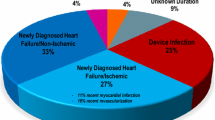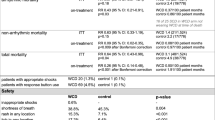Abstract
Purpose of review
The wearable cardioverter defibrillator (WCD) or LifeVest may protect against sudden cardiac death (SCD) in patients awaiting insertion of an implantable cardioverter defibrillator (ICD). The purpose of this communication is to review the rationale behind WCD therapy and to critically analyze recent data regarding its clinical efficacy. We seek to provide evidence-based recommendations regarding the potential role of the WCD in certain populations.
Recent findings
The only randomized controlled trial that evaluated WCD therapy did not demonstrate a reduced rate of arrhythmic death in patients prescribed the WCD during the first 90-day post-myocardial infarction (MI). However, when considering trial results alongside previous retrospective data, patient noncompliance with WCD therapy—rather than ineffectiveness of WCD therapy—remains an important theme.
Summary
The uncertainty of data regarding the use of WCD therapy in patients during ICD waiting periods should be considered as part of the shared decision processes between healthcare providers and patients. Higher rates of adherence are needed to ensure efficiency. Well-designed future studies with appropriate cost-effectiveness analyses are indicated to define the clinical efficacy of WCD therapy on arrhythmic and non-arrhythmic morbidity and mortality in patients who are not yet candidates for ICDs.
Similar content being viewed by others
References and Recommended Reading
Papers of particular interest, published recently, have been highlighted as: • Of importance •• Of major importance
Al-Khatib SM, Stevenson WG, Ackerman MJ, Bryant WJ, Callans DJ, Curtis AB, et al. 2017 AHA/ACC/HRS guideline for management of patients with ventricular arrhythmias and the prevention of sudden cardiac death. Circulation. 2018;138(13):e272–391. https://doi.org/10.1161/CIR.0000000000000549.Current AHA/ACC guidelines supporting use of WCDs in post MI patients.
Weinstock J. Use of the wearable cardioverter defibrillator as a bridge to implantable cardioverter defibrillator. Cardiac Electrophysiology Clinics. 2018;10(1):11–6. https://doi.org/10.1016/j.ccep.2017.11.002.
Elayi CS, Charnigo RJ, Heron PM, Lee BK, Olgin JE. Primary prevention of sudden cardiac death early post-myocardial infarction: root cause analysis for implantable cardioverter-defibrillator failure and currently available options. Circ Arrhythm Electrophysiol 2017;10(6). doi: https://doi.org/10.1161/CIRCEP.117.005194.
Hohnloser SH, Kuck KH, Dorian P, Roberts RS, Hampton JR, Hatala R, et al. Prophylactic use of an implantable cardioverter-defibrillator after acute myocardial infarction. N Engl J Med. 2004;351(24):2481–8.
Steinbeck G, Andresen D, Seidl K, Brachmann J, Hoffmann E, Wojciechowski D, et al. Defibrillator implantation early after myocardial infarction. N Engl J Med. 2009;361:1427–36. https://doi.org/10.1056/NEJMoa0901889.
Bigger JT. Prophylactic use of implanted cardiac defibrillators in patients at high risk for ventricular arrhythmias after coronary-artery bypass graft surgery. Coronary Artery Bypass Graft (CABG) Patch Trial Investigators. N Engl J Med. 1997;337:1569–75.
Solomon SD, Zelenkofske S, McMurray JJ, Finn PV, Velazquez E, Ertl G, et al. Sudden death in patients with myocardial infarction and left ventricular dysfunction, heart failure, or both. N Engl J Med. 2005;352(25):2581–8 Erratum in: N Engl J Med. 2005 Aug 18;353(7):744.
Brewster J, Sexton T, Dhaliwal G, Charnigo R, Morales G, Parrott K, et al. Acute effects of implantable cardioverter-defibrillator shocks on biomarkers of myocardial injury, apoptosis, heart failure, and systemic inflammation. Pacing Clin Electrophysiol. 2017;40(4):344–52. https://doi.org/10.1111/pace.13037.
Nikolski VP, Efimov IR. Electroporation of the heart. Europace. 2005;7(Suppl 2):146–54.
Poole JE, Johnson GW, Hellkamp AS, Anderson J, Callans DJ, Raitt MH, et al. Prognostic importance of defibrillator shocks in patients with heart failure. N Engl J Med. 2008;359(10):1009–17. https://doi.org/10.1056/NEJMoa071098.
Brooks GC, Lee BK, Rao R, Lin F, Morin DP, Zweibel SL, et al. Predicting persistent left ventricular dysfunction following myocardial infarction: the PREDICTS Study. J Am Coll Cardiol. 2016;67(10):1186–96. https://doi.org/10.1016/j.jacc.2015.12.042.
Swat SA, Cohen D, Shah SJ, Lloyd-Jones DM, Baldridge AS, Freed BH, et al. Baseline longitudinal strain predicts recovery of left ventricular ejection fraction in hospitalized patients with nonischemic cardiomyopathy. J Am Heart Assoc. 2018;7(20):e09841. https://doi.org/10.1161/JAHA.118.009841.
Chieng D, Paul V, Denman R. Current device therapies for sudden cardiac death prevention - the ICD, subcutaneous ICD and wearable ICD. Heart, Lung and Circulation. 2019;28(1):65–75. https://doi.org/10.1016/j.hlc.2018.09.011.
Piccini JP Sr, Allen LA, Kudenchuk PJ, Page RL, Patel MR, Turakhia MP, et al. Wearable cardioverter-defibrillator therapy for the prevention of sudden cardiac death: a science advisory from the American Heart Association. Circulation. 2016;133(17):1715–27. https://doi.org/10.1161/CIR.0000000000000394.
Kaspar G, Sanam K, Gholkar G, Bianco NR, Szymkiewicz S, Shah D. Long-term use of the wearable cardioverter defibrillator in patients with explanted ICD. Int J Cardiol. 2018;272:179–84. https://doi.org/10.1016/j.ijcard.2018.08.017.
Owen HJ, Bos JM, Ackerman MJ. Wearable cardioverter defibrillators for patients with long QT syndrome. Int J Cardiol. 2018;268:132–6. https://doi.org/10.1016/j.ijcard.2018.04.002.
Berger CJ, Murabito JM, Evans JC, Anderson KM, Levy D. Prognosis after first myocardial infarction. Comparison of Q-wave and non-Q-wave myocardial infarction in the Framingham Heart Study. JAMA. 1992;268(12):1545–51.
Cooper LT, Mather PJ, Alexis JD, Pauly DF, Torre-Amione G, Wittstein IS, et al. Myocardial recovery in peripartum cardiomyopathy: prospective comparison with recent onset cardiomyopathy in men and nonperipartum women. J Card Fail. 2012;18(1):28–33. https://doi.org/10.1016/j.cardfail.2011.09.009.
Chung MK, Szymkiewicz SJ, Shao M, Zishiri E, Niebauer MJ, Lindsay BD, et al. Aggregate national experience with the wearable cardioverter-defibrillator: event rates, compliance, and survival. J Am Coll Cardiol. 2010;56(3):194–203. https://doi.org/10.1016/j.jacc.2010.04.016.
Antiarrhythmics versus Implantable Defibrillators (AVID) Investigators. Antiarrhythmics versus Implantable Defibrillators (AVID) Investigators. A comparison of antiarrhythmic-drug therapy with implantable defibrillators in patients resuscitated from near-fatal ventricular arrhythmias. N Engl J Med. 1997;337(22):1576–83.
Bardy GH, Lee KL, Mark DB, Poole JE, Packer DL, Boineau R, et al. Amiodarone or an implantable cardioverter-defibrillator for congestive heart failure. N Engl J Med. 2005;352(3):225–37 Erratum in: N Engl J Med. 2005 May 19;352(20):2146.
Kutyifa V, Moss AJ, Klein H, Biton Y, McNitt S, MacKecknie B, et al. Use of the wearable cardioverter defibrillator in high-risk cardiac patients: data from the Prospective Registry of Patients Using the Wearable Cardioverter Defibrillator (WEARIT-II Registry). Circulation. 2015;132(17):1613–9. https://doi.org/10.1161/CIRCULATIONAHA.115.015677.
Feldman AM, Klein H, Tchou P, Murali S, Hall WJ, Mancini D, et al. Use of a wearable defibrillator in terminating tachyarrhythmias in patients at high risk for sudden death: results of the WEARIT/BIROAD. Pacing Clin Electrophysiol. 2004;27(1):4–9 Erratum in: Pacing Clin Electrophysiol. 2004 May;27(5):following table of contents.
Niwano S, Sekiguchi Y, Ishii Y, Iwasaki Y, Kato R, Okamura H, et al. Clinical usefulness of wearable cardioverter defibrillator (WCD) and current understanding of its clinical indication in Japan. Circ J. 2018;82(6):1481–6. https://doi.org/10.1253/circj.CJ-17-1336.
Liang JJ, Bianco NR, Muser D, Enriquez A, Santangeli P, D’Souza BA. Outcomes after asystole events occurring during wearable defibrillator-cardioverter use. World J Cardiol. 2018;10(4):21–5. https://doi.org/10.4330/wjc.v10.i4.21.
Mirro MJ, Keltner EE, Roebuck AE, Sears SF. Playing it close to the VEST and the clinical guidelines: clinical guideline compliance in HFrEF patients-role of WCD. Pacing Clin Electrophysiol. 2018;41(10):1314–20. https://doi.org/10.1111/pace.13472.
Olgin JE, Pletcher MJ, Vittinghoff E, Wranicz J, Malik R, Morin DP, et al. Wearable cardioverter-defibrillator after myocardial infarction. N Engl J Med. 2018;379(13):1205–15. https://doi.org/10.1056/NEJMoa1800781.VEST trial reference, the main study that evaluated efficacy of WCD.
Masri A, Altibi AM, Erqou S, Zmaili MA, Saleh A, Al-Adham R, et al. Wearable cardioverter-defibrillator therapy for the prevention of sudden cardiac death: a systematic review and meta-analysis. JACC: Clinical Electrophysiology. 2019;5(2):152–61. https://doi.org/10.1016/j.jacep.2018.11.011.
Boden WE, O’Rourke RA, Teo KK, Hartigan PM, Maron DJ, Kostuk WJ, et al. Optimal medical therapy with or without PCI for stable coronary disease. N Engl J Med. 2007;356:1503–16.
Agarwal M, Narcisse D, Khouzam N, Khouzam RN. Wearable cardioverter defibrillator “The LifeVest”: device design, limitations, and areas of improvement. Curr Probl Cardiol. 2018;43(2):45–55. https://doi.org/10.1016/j.cpcardiol.2017.04.002.
Author information
Authors and Affiliations
Corresponding author
Ethics declarations
Conflict of Interest
The authors declare that they have no conflicts of interest.
Human and Animal Rights and Informed Consent
This article does not contain any studies with human or animal subjects performed by any of the authors.
Additional information
Publisher’s Note
Springer Nature remains neutral with regard to jurisdictional claims in published maps and institutional affiliations.
This article is part of the Topical Collection on Arrhythmia
Rights and permissions
About this article
Cite this article
Kirolos, I., Jones, D., Hesterberg, K. et al. Recent Updates in the Role of Wearable Cardioverter Defibrillator for Prevention of Sudden Cardiac Death. Curr Treat Options Cardio Med 21, 49 (2019). https://doi.org/10.1007/s11936-019-0746-z
Published:
DOI: https://doi.org/10.1007/s11936-019-0746-z




